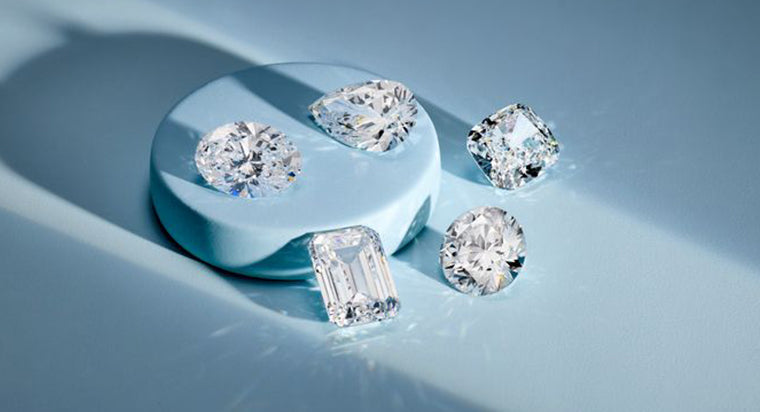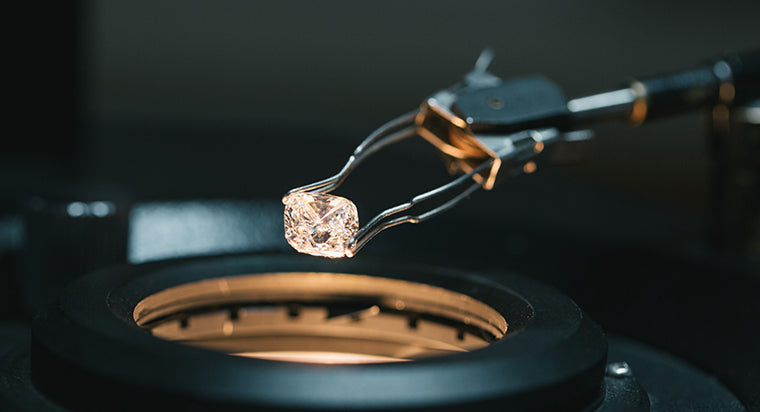VVS2 Diamond vs VVS1 Diamond: How Are These Clarity Grades Actually Different?

You've learned everything there is to know about diamond cut quality, color and carat weight. The last piece of the puzzle? Diamond clarity.
Understanding clarity is one of the most important parts of selecting a loose diamond because it has a big impact on the overall look of your ring. However, there are so many clarity grades that it's difficult to really know which is which. Two you'll hear about constantly during your diamond engagement ring search are VVS1 and VVS2. These two grades can give you the most bang for your diamond buck, but what's the difference? Let's break down VVS2 vs. VVS1 diamonds to help get more clarity into your search.
TABLE OF CONTENTS
Why VVS Diamonds are a Good Choice
In a perfect world, we'd all rock diamond engagement rings with Flawless (FL) or Internally Flawless (IF) stones. These are the closest-to-perfect diamonds out there, but unfortunately the price also reflects their perfection — and it's not always affordable. (These diamonds are incredibly rare, thus the higher price tags.)
Luckily, you can get the same sort of look for a lot less money when you opt for a VVS diamond. A VVS — Very, Very Slightly Included — diamond is one with tiny imperfections that are almost impossible to see. These are minute inclusions that are not visible under 10x magnification. The inclusions (or flaws) are pretty much impossible to see with the naked eye, too.

So, why are VVS diamonds a better choice? It all comes down to price. While FL or IF diamonds can be prohibitively expensive, VVS diamonds are close to the same looks-wise, but considerably less expensive. We're not saying there's no difference. Under a microscope, the difference can be big. But you're likely never going to look at your rock this way, so what's important is how it looks to the eye. And this is where VVS diamonds look remarkably similar to IF or FL diamonds.
Even better: VVS clarity diamonds are in high demand due to price, so they actually hold more value over time when compared to IF and FL diamonds.
VVS2 vs VVS1: What's the Difference?
There are multiple levels of VVS diamonds, ranging from VVS1 — a step below IF — and VVS2. The inclusions on both the VVS1 and VVS2 diamonds are tiny, but they tend to be off center (with VVS1 diamonds) or closer to the table (with VVS2 diamonds).

The number of inclusions vary per level in the VVS2 vs. VVS1 debate: VVS1 diamonds usually have one or two imperfections (typically pinpoint and natural). The average VVS2 diamond will have several that range from multiple pinpoint inclusions to indented natural and feathers.
So to put it simply: VVS2 diamonds tend to have more inclusions than VVS1 diamonds.
Lab Grown VVS Diamonds vs Natural VVS Diamonds
Because natural diamonds and lab grown diamonds are chemically and optically identical, this means that they their visual appearance will be the same when the grading values are the same. This is why it's essential to purchase only certified center diamonds for your engagement ring. Whether it's an IGI certified diamond or one certified by GIA, the VVS grade is only assigned for diamonds that are eye-clean and have minimal inclusions that can only be seen under magnification.
Rest assured, a VVS grade is among the cream of the crop when looking at premium diamond quality and clarity. The major difference lies in the value and the production effort taken to grow a lab diamond versus mining a natural diamond from within the earth. For a diamond of the same quality, you can expect a price difference of about 30%. Therefore, if you're looking to maximize on carat size and quality, a lab diamond may work well for you. However, if you're looking for a more traditional purchase a natural diamond may be your best option.
VVS2 vs VVS1: How their Prices Stack Up
First thing's first: Always make sure that the VVS1 or VVS2 diamonds you buy have been graded by accredited organization, like the Gemological Institute of America (GIA). This ensures that you're getting the diamond — and the clarity — you want.
The next biggest factor to look at when considering VVS2 vs. VVS1 diamonds? The price.
Both VVS1 and VVS2 diamonds are considerably less expensive than FL or IF diamonds. However, there is a big price difference between VVS grades, too.
Typically, similar cut, color, and carat VVS2 vs. VVS1 diamonds will differ somewhere around 25 percent. VVS1 diamonds being the more expensive of the two grades. The best part? You probably won't be able to tell the difference between the two.
VVS2 vs. VVS1 diamonds: How to Pick the Best for You
Still not sure who should win the VVS2 vs. VVS1 diamond debate? Here are a few key things to remember, both grades of diamonds will be eye-clean diamonds. This means that it will be impossible for anyone to pick out the inclusions. The inclusions will not be visible to the naked eye. While this grade of diamonds is not flawless, the flaws are hard to detect and see.
FAQs
How to tell if a diamond is a vvs diamond?
To determine if a diamond is a VVS (very very slightly included) diamond, the following methods can be used:
- Gemological grading report: A gemological grading report from a reputable laboratory such as the Gemological Institute of America (GIA) or the International Gemological Institute (IGI) will indicate the diamond's clarity grade, including if it is VVS.
- Visual inspection: A VVS diamond will have very few, if any, visible inclusions to the naked eye. However, this can be difficult for an untrained eye and requires a good source of lighting.
- Magnification: A 10x loupe or microscope can be used to examine the diamond for inclusions. A VVS diamond will have very small inclusions that are difficult to see even under magnification.
- Expert opinion: A trained gemologist or diamond appraiser can examine the diamond and determine its clarity grade, including if it is VVS.
It's important to note that while these methods can provide information about the clarity grade of a diamond, they do not guarantee the authenticity or quality of the diamond. To ensure that you are buying a genuine VVS diamond, it is recommended to purchase from a reputable dealer or jeweler.
Can I see the inclusions on a vvs diamond without a microscope?
Are vvs diamonds worth the price?
Whether a VVS (very very slightly included) diamond is worth the price depends on several factors, including personal preferences and budget. Here are a few things to consider:
- Clarity: VVS diamonds are considered to be of very high clarity and are among the top grades in the diamond clarity scale. This can make them a good choice for those who value clarity and want a diamond with few inclusions.
- Rarity: VVS diamonds are relatively rare and, as a result, can be more expensive than diamonds with lower clarity grades.
- Quality: VVS diamonds are considered to be of high quality and can offer a good combination of clarity, brightness, and fire.
- Personal preference: The value of a diamond is subjective and depends on personal preferences. Some people may be willing to pay more for a VVS diamond, while others may not place as much value on clarity.
- Budget: The price of a VVS diamond can vary depending on factors such as carat weight, cut, color, and certification. It is important to consider your budget and determine what you are willing to spend on a diamond.
Are lab grown diamonds always high clarity grades like vvs?









